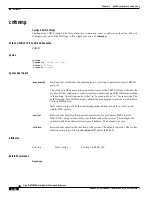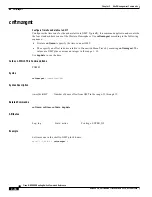
2-28
Cisco MGX 8850 Routing Switch Command Reference
Release 2.0, Part Number 78-10467-04 Rev C0, October 2001
Chapter 2
Shelf Management Commands
cnfndparms
Syntax Description
option number
A number that selects the option. The current parameters begin with number 2:
•
Option 1 is the number of seconds to count the resets of the shelf management
cards. The range is 0–65355 (a 16-bit decimal number). The default is 3600
seconds (1 hour). A 0 means an infinite time period. The impact of an infinite
time period is that only a specified count of resets can stop the resets.
•
Option 2 is the maximum number of resets of the shelf management card group
per time period. The number is an 8-bit decimal number and therefore has the
range 0–255. The meaning of a 0 for this parameter is an infinite number of
resets—the resets can continue regardless of the number. The default is 3 resets
per period (see Option 2).
•
Option 3 lets you enable or disable core card redundancy. Enter “yes” to enable
or “no” to disable alarms on a missing, redundant core card. The default is enable,
which means an alarm appears in the absence of a redundant core card.
•
Option 4 lets you enable or disable expanded memory on the PXM45/B. Enter
“yes” to enable or “no” to disable The default is disable.
•
Option 5 you specify the locations of required power supplies in an AC-powered
system. The number is 8-bit hexadecimal:
–
0x0 (the default) means no specified power supply requirement related to this
particular form of alarm generation (although the configuration must still
meet the power requirements of the switch).
–
0x01: PSU A1 is required.
–
0x02: PSU A2 is required.
–
0x04: PSU A3 is required.
–
0x10: PSU B1 is required.
–
0x20: PSU B2 is required.
–
0x40: PSU B3 is required.
•
Option 6 lets you specify the location of one or more required fan trays. The
number is 8-bit hexadecimal:
–
0 for no specific fan try requirement
–
0x01 for bottom fan tray required
–
0x02 for top fan tray required
option value
The option value can be a decimal or hexadecimal number or a “yes” or “no” entry.
The following shows the possible ranges or values for each type of numeric option.
8-bit decimal: 0–255
16-bit decimal: 0–65535
32-bit decimal: 0–4294962795
8-bit hexadecimal: 0–0xff
16-bit hexadecimal: 0–0xffff
32-bit hexadecimal: 0–0xffffffff
















































